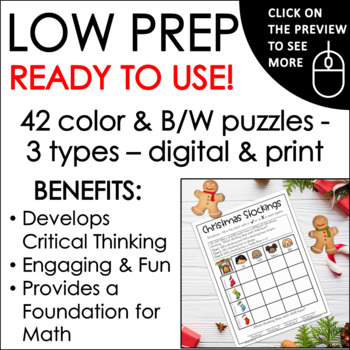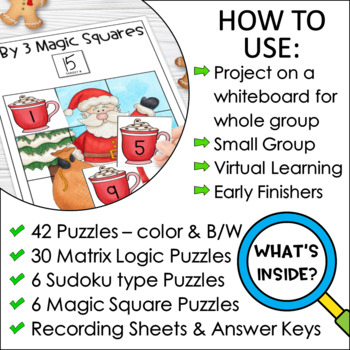Christmas Logic Puzzles & Critical Thinking Skills Activities - Print & Digital
- Zip
- Google Apps™

What educators are saying
Also included in
- This is a bundle of my five CHRISTMAS CRITICAL THINKING PRODUCTS for grades 1-3. This bundle teaches logic and deductive reasoning, analogies and classifying, and attribute listing to get your kiddos thinking at those higher levels. This bundle is completely updated with new clip art and fonts andPrice $13.60Original Price $17.00Save $3.40
- Engage your students all year long with these fun and challenging printable logic puzzles that will help them develop important critical thinking skills! With 5 different sets and over 180 2nd grade logic puzzles for you to choose from, your students will remain engaged throughout any season. ThesePrice $11.75Original Price $20.00Save $8.25
Description
Add some holiday fun to your day with these Christmas Logic Puzzles and critical thinking skills activities. These fun Christmas activities will challenge your students and help them develop skills in logical thinking, problem-solving, making inferences, drawing conclusions, recognizing similarities and differences, AND comparing and contrasting.
This set of Christmas critical thinking activities includes 42 puzzles in print AND digital formats:
❤ 6 Christmas Sudoku puzzles using pictures
❤ 30 Christmas logic puzzles (3 two by two grids, 16 three by three grids, and 11 four by four grids)
❤ 6 Magic Square Puzzles
❤ Candy cards for Sudoku puzzles
❤ Yes/no cards for logic puzzles
❤ Answer keys for all the puzzles
❤ Sheets to record responses
❤ Google drive versions of each puzzle
Preview this resource to see samples of the different Christmas Logic Puzzles included.
⭐️ Ideas for using these Christmas activities ⭐️
- In a Center: Print out the logic puzzles on cardstock and laminate or put them in a dry erase pocket. Print out the solution cards & response sheets so students can check their work.
- As a Morning Warm-up Activity: Project the puzzles on a SmartBoard, use an LCD projector, or use an ELMO. Print out the Christmas logic puzzles on paper and use them as a worksheet. Have students work individually or in pairs.
- Think, Pair, Share: Print out the Christmas logic puzzles on plain paper or card stock. Give each group of students a puzzle to solve.
- For Early Finishers: Have a folder of the puzzles in an early finisher center.
⭐️ Bundle & Save ⭐️
This product is part of my Christmas Critical Thinking Activities Bundle which includes all my Christmas critical thinking resources at a big discount.
PLEASE NOTE:The digital versions of the files are stored on Google™ Drive and formatted as Google™ Slides. You will need a Google™ Classroom or Google™ Drive account to access these files. There is a PDF file included in the download with links to the three files. You will click on each link. A page will appear that allows you to make a copy of the file to your Google™ account.
More Christmas Critical Thinking Activities
Christmas Analogies For Grades 1-3
Christmas Logic With a String of Lights
Christmas Which One Doesn’t Belong?
Christmas Critical Thinking Bundle
More Logic Puzzles for Critical Thinking Skills
Spring Matrix Logic Puzzles for Grades 1-3
St. Patrick’s Day Beginning Logic Puzzles for Grades 1-3
Beginning Logic Puzzles for Back to School and Fall Gr. 1-3
Beginning Logic Puzzles for Winter Grades 1-3
Remember to always … Keep 'em Thinking!
© Susan Morrow. This purchase is for single classroom use only. Sharing this resource with multiple teachers, an entire school, or an entire school system is strictly forbidden. Multiple licenses are available at a discount.







